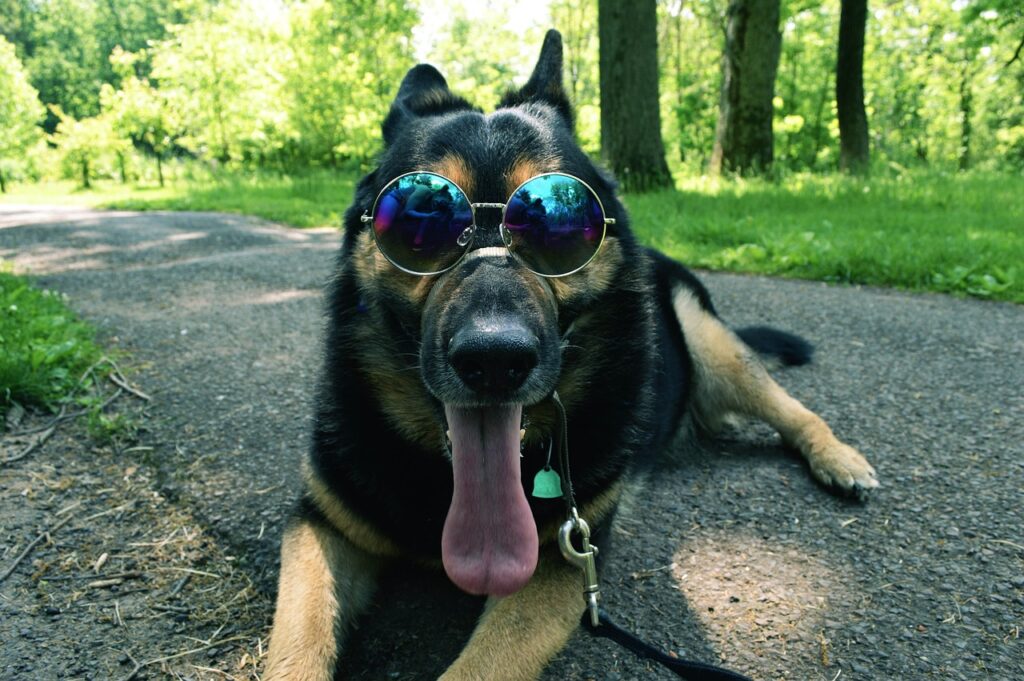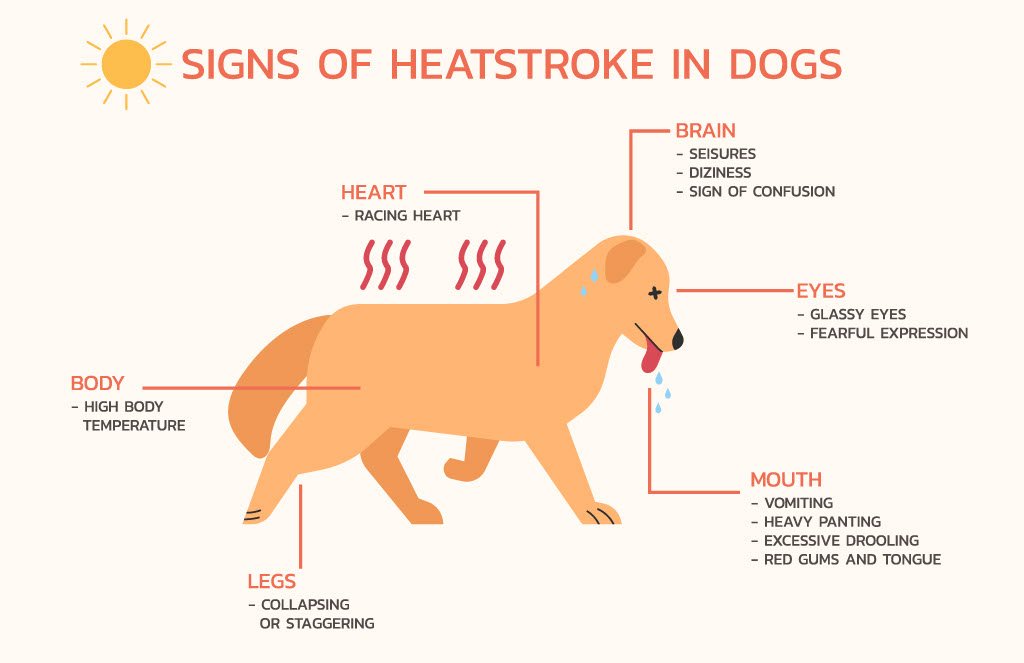
Dogs can get dehydrated and overheated in August. If your dog pants heavily, it may be at risk of heatstroke. SMP PAWS offers indoor air-conditioned doggie daycare and takes dogs to places like Bloomingdale’s and Target for training and treats. Dogs can overheat easily because of their high body temperature and fur. They can’t regulate their body temperature like humans do and depend on panting. Dehydration or overexposure to heat can cause heat exhaustion or even heatstroke, which is deadly. To prevent this, keep your dog hydrated and avoid excessive heat exposure.
Heat Exhaustion vs. Heatstroke?

Pugs, French Bulldogs, English Bulldogs, Boxers, and Pekingese can struggle to cool down on hot days, making them vulnerable to heat exhaustion. This is when their body temperature rises which can leave them feeling exhausted or even lead to heatstroke. A dog’s temperature above 103°F (39.4°C) is considered hyperthermic, and anything above 106°F (41°C) can lead to heatstroke. If a pet’s temperature reaches 107°F to 109°F (41.2°C to 42.7°C), it can result in organ failure or death. It’s a good idea to have a pet thermometer on hand.
The Role of Panting in Keeping a Dog Cool

Dogs pant to cool down as they don’t sweat like humans. Their breathing rate increases, evaporating moisture from their respiratory tract and tongue, which lowers their body temperature. However, excessive panting can indicate heat exhaustion. Keep them cool, hydrated, and avoid overexertion to prevent risks. Monitor their behavior for potential heat-related issues, and take precautions to prevent heat exhaustion to ensure their safety.

The most telling sign of heat stroke in dogs is excessive panting or difficulty breathing. If your dog is panting constantly or faster than normal (hyperventilation), they could be overheated.
Other symptoms may include:
Your dog appearing lethargic, disoriented or non-responsive;*
An elevated heart rate and body temperature;*
Excessive thirst or drooling;*
Glazed or glassy eyes accompanied by a worried expression;*
Bright or dark red tongue or gums;*
Vomiting and diarrhea;*
Staggering/Seizure/Loss of consciousness/Collapse.*
*When in doubt, call your local vet. Keeping your dog safe and healthy is the most important thing. If your dog seems severely ill (vomiting, staggering, seizing, etc.) or has lost consciousness, get them to a veterinary hospital immediately.
Ways to Cool an Overheated Dog
Remove them from direct sunlight and take them to the cover of shade, preferably to cooler temperatures indoors, if possible, or to an air-conditioned car.
Provide them with continuous sips of cool water to drink every couple of minutes to help them rehydrate safely. Don’t use cold water, as it may lower their body temperature too fast, which can cause more complications – so avoid putting ice in their water if they seem overheated.
Pour cool or lukewarm water over their head, stomach, armpits and feet or wipe them down with a cool, wet cloth. The evaporative cooling that results will lower a dog’s body temperature and cool them off. Repeat as many times as necessary until the dog’s symptoms have subsided. (Remember to avoid using cold water, as it may lower their body temperature too fast, which can cause more complications.)
If inside, place them in front of a fan to speed up the cooling process, but only until their body temperature has returned to normal (or you might cause hypothermia!)
If you can get your dog’s body temperature down to 103 degrees, then they are moving into the clear, but we would advise that you still call your vet as soon as possible. Even if your dog seems to be recovering, they may need to be monitored for shock, dehydration, kidney failure, and other possible complications of heat exhaustion, so your vet will be able to advise you about next step.
How to Keep a Dog Cool on a Hot Day:
There are a wide variety of water bottles that make giving your dog water on the go easy. We especially like the Malsipree Water Bottle for Dogs because of its lightweight and stylish design and because leftover water in the dispenser bowl can be returned to the bottle for reuse.
1. Keep a dog hydrated
On a hot day, keeping your dog well-hydrated and cool by making sure they always have access to water, shade or a well-ventilated place to rest should be your number one priority. This may mean setting up water bowls in multiple places around your home or yard and always making sure to carry a supply of water with you on the go, so that you can ensure your dog stays hydrated and able to cool themselves down, no matter where they are.
Indoors, you may notice your dog is naturally seeking out cool, dark spaces to relax, perhaps under a couch or bed, so following suit and shifting their bed, crate or pen to a spot that’s away from direct sunlight will definitely help to keep them comfy and cool, as will fans and air conditioning. Outdoors, a dog should always have access to shade, as well, so if none is available, it’s far better to skip yard time during the high heat of the day and keep your dog inside.
To combat boredom and make staying inside more fun, preparing enrichment toys like frozen Kongs or making your dog homemade popsicles can help to keep them happily occupied. Some of our favorite “beat the heat” products for dogs include cooling mats for indoor comfort, portable water bottles for pets on the go, and foldable dog pools or extra large water bowls for backyard fun.
2. Never leave a dog unattended in a parked car.
Regardless of whether the car windows are open or closed, dogs should never be left unattended in a parked car on a hot day for any reason. The temperature inside a parked car exposed to direct sunlight can rise rapidly, turning it into an oven that can quickly lead to the death of the poor dog stuck inside, within just 10-20 minutes! On hot summer days, it’s much better to leave a dog at home than to take them with you if you can’t avoid leaving them alone in your car. There are no exceptions! (Unless you own a Tesla with the “dog mode” feature).
5. Dogs instinctively avoid the heat
It’s crucial to pay attention to your furry friend’s body language during hot weather. Dogs can suffer from heat exhaustion just like humans, so it’s important to keep them comfortable. Make sure they have access to shade and clean water at all times, and consider setting up a fan or misting system to help keep them cool. Indoors, tile floors can be a lifesaver during heat waves. If you notice any signs of heat stress, such as heavy panting, lethargy, or disorientation, seek veterinary care immediately. Remember, prevention is key when it comes to protecting your dog from heat-related dangers.
3. Avoid vigorous exercise
Dogs can get heat stroke from too much exercise in hot weather, even if it doesn’t seem that hot outside. Give your dog shorter periods of exercise with plenty of breaks and water. Walk or run them in the cooler times of day, or keep them inside with enrichment activities if it’s too hot.
4. Use the “Seven Second Rule”
The easiest way to check if it’s too hot to walk your dog is by testing whether you can keep your hand on the pavement or ground for a full seven seconds. A dog’s paws can quickly get burned by hot pavement or exposed earth, even on just an average summer day. The “Seven-Second Rule” determines whether the pavement or a hiking path is too hot for your dog to walk on. Simply place your hand on the ground and see if you can keep it there for a full seven seconds. If not, it’s too hot to walk your dog outside, and it’s best to wait for the heat of the day to die down before heading out. Keep in mind that black tar road surfaces get much hotter than concrete, so please choose your walking routes wisely.
SMP PAWS | Los Angeles, a dog & puppy training company that specializes in positive dog training and solving problem dog behavior like dog separation anxiety, leash reactivity, and aggression. We are certified as Association of Professional Dog Trainers by the Council of Professional Dog Trainers (CAPDT) and is available for online dog training sessions via WhatsApp, Facetime, Hangouts or Zoom.

